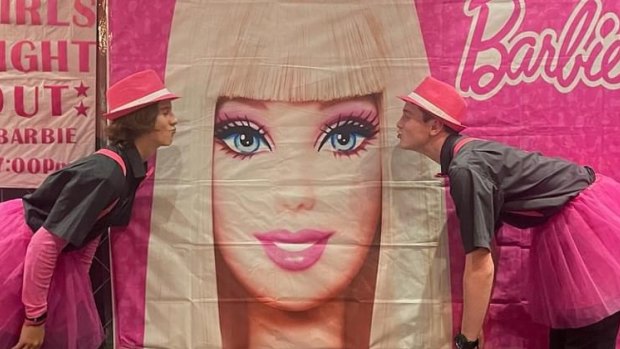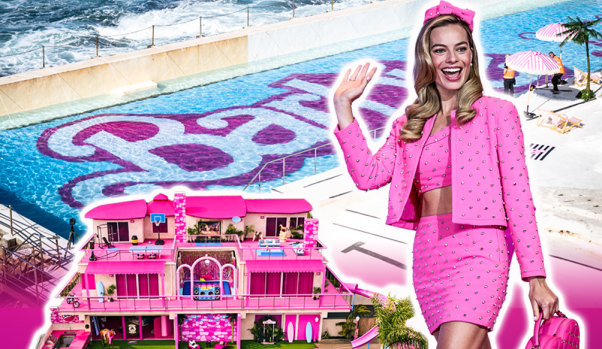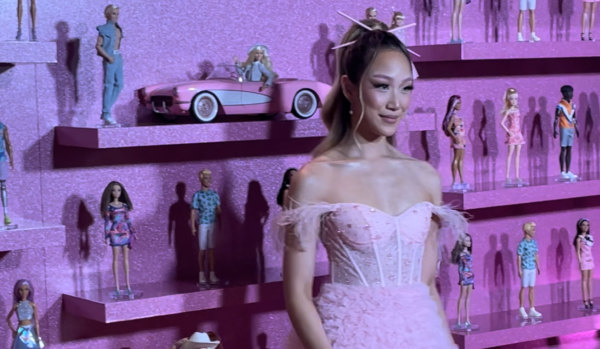By Garry Maddox
Business was so tough just five weeks ago that Kieren Dell was considering closing some of his country cinemas.
The chief executive of Majestic Cinemas, an independent chain in northern NSW and south-east Queensland, had survived an even more brutal financial year than during COVID, without support from governments, banks and landlords.

Staff welcome Barbie at Majestic Cinemas, where the movie has turned ticket sales around.Credit: Majestic
But Barbie, which will take just 17 days to become the biggest movie in Australian cinemas this year, has kept the doors open and ticket sellers even busier than hoped in the regions.
“What surprised me was the number of 50, 60 and even 80-year-old women who were salivating at the prospect of seeing Barbie,” Dell said. “People at the shops are talking about Barbie and, to a degree, Oppenheimer as well.”
Around the country, Greta Gerwig’s subversive and heartfelt comedy has had fans returning for a second and third time as cinema’s biggest cultural event in years, Barbenheimer, continues.
It is benefiting from what the movie’s distributor, Universal Pictures International’s managing director Mike Baard, calls “the book club effect”: large groups of women going together.

Hi Barbie! Greta Gerwig’s subversive comedy, which stars Margot Robbie, will need only 17 days to become the year’s biggest movie in Australian cinemas.
“It’s a phenomenon we first experienced with the original Mamma Mia! back in 2008,” he said. “That’s where you get that repeat business coming in. There might be six, eight, 10, 12 or 14 in a group.”
Although box office temporarily dipped when the Matildas played Canada at the World Cup on Monday night, cinema executives believe Barbie will pass the $51.7 million taken by the year’s biggest hit, The Super Mario Bros Movie, on Friday.
Hoyts chief executive Damian Keogh, who originally thought Barbie would take $20 million, now expects it to take a stunning $75 million.
“The nostalgia thing has hit big,” he said. “And it’s done very well with younger viewers.”
Keogh said Barbie’s success was largely driven by women and girls. Data from Hoyts’ loyalty program showed it was also attracting patrons who hadn’t been to the movies this year.
Baard thinks Barbie could even take $80 million.
That would make it the country’s seventh highest-grossing movie, with the original Avatar still leading the way ($119 million) from Star Wars: The Force Awakens ($94.1 million), Avatar: The Way of Water ($93.7 million) and Top Gun: Maverick ($93.4 million).
Baard, whose company is also distributing Christopher Nolan’s epic Oppenheimer, said he was delighted by how popular both had been since opening on the same day.

“The marketing of the two films somehow helped each other. Somehow one plus one has equalled three”: Scene from Barbie’s Sydney premiere.
“The marketing of the two films somehow helped each other,” he said. “Somehow one plus one has equalled three.”
Baard believes Oppenheimer might even have attracted more second viewings than Barbie.
“It’s a welcome reminder of the power of cinema,” he said. “It’s so easy to compartmentalise the story and perhaps suggest it’s a dry, three-hour biopic about events that happened when most people weren’t even born yet [Nolan] has made it so current and also about the human experience.”
Keogh originally expected Oppenheimer to take up to $25 million, attracting a more even but largely older spread of male and female viewers than Barbie. He now thinks it will now take at least $35 million.
Oppenheimer is set for a long run based on ticket sales alone at the country’s only IMAX cinema at Melbourne Museum. Sydney’s IMAX is due to open within weeks.
It has sold out every session in Nolan’s preferred format, giant-screen IMAX 1570 Film, until mid-September. Many sessions in a digital format, 4K Laser, are also booked out on weekends.
Worldwide, Barbie has taken $US850 million ($1.3 billion) and is expected to become one of the fastest non-franchise movies to take $US1 billion within days.
Oppenheimer has taken more than $US425 million so far.
Email Garry Maddox at gmaddox@smh.com.au and follow him on Twitter at @gmaddox.
Find out the next TV, streaming series and movies to add to your must-sees. Get The Watchlist delivered every Thursday.